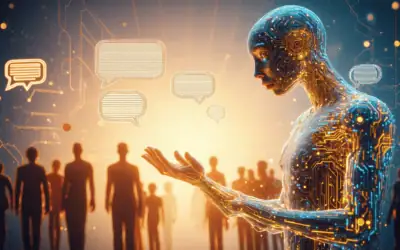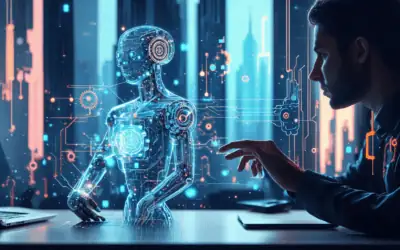Key Takeaways
- Learn how to effortlessly make your own chatbot by following a structured, step-by-step approach.
- Utilize user-friendly AI chatbot generators to create a customized chatbot without extensive programming knowledge.
- Understand the importance of defining your chatbot’s purpose and target audience for effective user engagement.
- Implement best practices such as regular testing, user feedback incorporation, and performance monitoring for chatbot success.
- Explore various platforms, including popular options like Botpress and HubSpot, to find the right fit for your chatbot development needs.
- Utilize advanced technologies like Natural Language Processing (NLP) and machine learning to enhance chatbot interactions.
- Access free resources and trials to create your own chatbot free and engage users effectively.
In today’s digital landscape, the ability to make your own chatbot has become an invaluable skill for businesses and individuals alike. This comprehensive guide will walk you through the essential steps to create your own AI chatbot effortlessly, whether you’re a tech novice or an experienced developer. We will explore the basics of chatbots, the significance of AI chatbot generators, and how you can leverage platforms to create a chatbot online for free. Additionally, we will delve into the capabilities of ChatGPT and provide a step-by-step approach to build your own chat bot tailored to your unique needs. By the end of this article, you will have a clear understanding of how to make your own AI bot, the costs involved, and the best practices for successful chatbot development. Join us as we unlock the potential of AI technology and empower you to create your own chatbot free today!
Understanding the Basics of Chatbots
Creating your own chatbot can significantly enhance user engagement and streamline communication. A chatbot is an AI-driven tool designed to interact with users through text or voice, providing automated responses to inquiries and facilitating various tasks. Understanding the fundamentals of chatbots is essential for anyone looking to make your own chatbot.
Defining Your Chatbot’s Purpose
Creating your own chatbot involves several key steps that ensure it meets your specific needs and functions effectively. Here’s a comprehensive guide to help you through the process:
- Define Your Objectives: Clearly identify what you want your chatbot to accomplish. Common goals include answering customer inquiries, processing orders, or scheduling appointments.
- Identify Your Target Audience: Understand who will interact with your chatbot. This will help tailor the conversation style and functionality to meet user expectations.
- Select the Deployment Platform: Decide where your chatbot will be available. Options include websites, messaging apps (like Facebook Messenger), or mobile applications.
- Design the Conversation Flow: Map out the key interactions your chatbot will handle. This includes anticipating user questions and planning appropriate responses.
- Choose a Chatbot Development Platform: Utilize user-friendly platforms that allow you to create your own AI chatbot without extensive coding knowledge. Some popular options include:
- Botpress: An open-source conversational AI platform that supports various Natural Language Understanding (NLU) libraries.
- HubSpot: Offers a free chatbot builder to automate customer interactions effectively.
- Tidio: A platform designed for creating chatbots specifically for websites.
- Consider Coding from Scratch: If you have programming skills (e.g., in Python or JavaScript), building a chatbot from scratch offers greater customization. This involves:
- Implementing NLU to interpret user input.
- Creating a knowledge base to provide accurate responses.
- Testing and Iteration: Rigorously test your chatbot to ensure it operates as intended. Gather user feedback to identify areas for improvement.
- Deployment: Once testing is complete, deploy your chatbot on the chosen platform. Ensure it is easily accessible to your target audience.
- Monitor Performance: Continuously track your chatbot’s interactions and performance metrics. Use analytics to refine its functionality and enhance user experience.
- Scalability Considerations: Choose a platform that can accommodate your expected user volume, ensuring your chatbot remains responsive and effective as demand grows.
By following these steps, you can create a chatbot that not only meets your needs but also provides a valuable resource for your users.
The Importance of AI Chatbot Generators
AI chatbot generators play a crucial role in simplifying the process of building your own chat bot. These platforms offer intuitive interfaces and pre-built templates that allow users to design chatbots without extensive technical knowledge. By leveraging an AI chatbot generator, you can:
- Accelerate the development process, enabling quicker deployment of your chatbot.
- Access advanced features such as natural language processing, which enhances user interactions.
- Utilize analytics tools to monitor performance and improve user experience over time.
Choosing the right AI chatbot generator can significantly impact the effectiveness of your chatbot, making it essential to explore various options available in the market.
Understanding the Basics of Chatbots
To make your own chatbot, it’s essential to grasp the foundational concepts that define what chatbots are and how they function. Chatbots are AI-driven programs designed to simulate human conversation through text or voice interactions. They can be integrated into various platforms, including websites, social media, and messaging apps, to enhance user engagement and streamline communication.
At their core, chatbots utilize natural language processing (NLP) to understand and respond to user inquiries. This technology allows them to interpret user intent and deliver relevant information or assistance. As you embark on your journey to create your own AI chatbot, consider the different types of chatbots available, such as rule-based bots, which follow predefined scripts, and AI-powered bots, which learn from interactions to improve their responses over time.
The Importance of AI Chatbot Generators
AI chatbot generators play a crucial role in simplifying the process of creating your own chatbot. These platforms provide user-friendly interfaces that allow individuals and businesses to build customized chatbots without extensive programming knowledge. By leveraging an AI chatbot generator, you can quickly design a bot tailored to your specific needs, whether for customer support, lead generation, or enhancing user experience.
Moreover, using an AI chatbot generator can significantly reduce development time and costs. Many platforms offer free trials or basic versions, enabling you to explore their features before committing financially. This accessibility allows anyone to make their own chatbot and engage with users effectively. As you explore these options, consider the scalability and integration capabilities of the generator you choose, ensuring it aligns with your long-term goals.
Understanding the Basics of Chatbots
To make your own chatbot, it’s essential to grasp the fundamental concepts behind chatbot technology. Chatbots are AI-driven programs designed to simulate human conversation, enabling businesses to automate interactions with users. They can be deployed across various platforms, including websites, social media, and messaging apps, enhancing customer engagement and streamlining communication.
At their core, chatbots utilize natural language processing (NLP) to understand and respond to user inquiries. This technology allows them to interpret user intent and provide relevant answers, making them invaluable for customer service and support. By leveraging an AI chatbot generator, you can create your own AI chatbot tailored to your specific needs, whether for lead generation, customer support, or information dissemination.
The Importance of AI Chatbot Generators
Utilizing an AI chatbot generator is crucial for businesses looking to enhance their digital communication strategies. These platforms simplify the process of creating your own AI chatbot by providing user-friendly interfaces and pre-built templates. With these tools, you can build your own chat bot without extensive programming knowledge.
One notable option is Brain Pod AI, which offers a range of features for developing custom chatbots. Their platform allows you to create and deploy chatbots quickly, ensuring that you can engage with your audience effectively. Additionally, many AI chatbot generators, including CustomGPT.AI, offer free trials, enabling you to explore their capabilities before committing financially. This accessibility makes it easier for businesses of all sizes to create your own chatbot free and enhance customer experiences.
Creating Your Own AI Bot
When it comes to creating your own AI bot, understanding the underlying technologies is crucial. AI chatbots leverage natural language processing (NLP) and machine learning to interact with users effectively. By grasping these concepts, you can better design a bot that meets your specific needs. Whether you want to make your own chatbot for customer service or personal use, the foundational knowledge will guide your development process.
Understanding AI Technologies for Chatbots
AI technologies play a pivotal role in the functionality of chatbots. Here are some key components to consider:
- Natural Language Processing (NLP): This technology enables chatbots to understand and interpret human language, allowing for more natural interactions.
- Machine Learning: By utilizing machine learning algorithms, your chatbot can improve its responses over time based on user interactions, enhancing its effectiveness.
- Integration with APIs: Connecting your chatbot with various APIs can expand its capabilities, allowing it to access external data and services.
By leveraging these technologies, you can build your own AI bot that not only responds to queries but also learns and adapts to user preferences.
Best Practices for AI Bot Development
To ensure the success of your chatbot, consider the following best practices:
- Define Clear Objectives: Before starting, outline what you want your chatbot to achieve. This could range from answering FAQs to facilitating transactions.
- User-Centric Design: Focus on creating a user-friendly interface that simplifies interactions. The easier it is for users to engage, the more effective your bot will be.
- Regular Testing and Updates: Continuously test your chatbot to identify areas for improvement. Regular updates will help maintain its relevance and efficiency.
By adhering to these best practices, you can effectively create your own chatbot that meets user expectations and enhances engagement.
How to Make Your Own Chatbot
Creating your own chatbot can be an exciting venture, especially with the advancements in AI technology. By following a structured approach, you can build a chatbot that meets your specific needs and enhances user engagement. Here’s a comprehensive guide to help you navigate the process of making your own chatbot.
Comprehensive Guide to Chatbot Creation
To successfully make your own chatbot, consider the following steps:
- Define Your Purpose: Clearly outline what you want your chatbot to achieve. Whether it’s for customer support, lead generation, or providing information, having a defined purpose will guide your development process.
- Select a Platform: Choose an AI chatbot generator that suits your needs. Platforms like Messenger Bot offer user-friendly interfaces and robust features for building your own chat bot.
- Design the Conversation Flow: Map out how interactions will occur. This includes the questions your chatbot will ask and the responses it will provide. A well-structured conversation flow enhances user experience.
- Develop and Test: Utilize the platform’s tools to create your chatbot. After development, conduct thorough testing to ensure it functions as intended and provides accurate responses.
- Launch and Monitor: Once satisfied with the performance, launch your chatbot. Continuously monitor its interactions and gather feedback to make necessary adjustments.
By following these steps, you can effectively create your own AI chatbot that serves your business needs and engages users effectively.
Common Mistakes to Avoid When Making Your Chatbot
While creating your chatbot, it’s essential to avoid common pitfalls that can hinder its effectiveness:
- Overcomplicating Conversations: Keep interactions simple and intuitive. Users appreciate straightforward responses rather than convoluted dialogues.
- Neglecting User Feedback: Failing to incorporate user feedback can lead to a stagnant chatbot. Regularly update your chatbot based on user interactions and suggestions.
- Ignoring Analytics: Utilize analytics tools to track performance metrics. Understanding user behavior can help you refine your chatbot and improve engagement.
- Underestimating Maintenance: A chatbot requires ongoing maintenance to ensure it remains relevant and functional. Regular updates and checks are crucial for long-term success.
By being aware of these common mistakes, you can enhance the effectiveness of your chatbot and provide a better experience for your users.
How to Make Your Own Chatbot
Creating your own chatbot can be an exciting venture, especially with the advancements in AI technology. By following a structured approach, you can design a chatbot that meets your specific needs and enhances user engagement. Here’s a comprehensive guide to chatbot creation.
Comprehensive Guide to Chatbot Creation
To successfully make your own chatbot, consider the following steps:
- Understand the Fundamentals of AI and Chatbots: Familiarize yourself with AI concepts, natural language processing (NLP), and chatbot architectures. Resources like “Deep Learning” by Ian Goodfellow and online courses from platforms such as Coursera can provide foundational knowledge.
- Define Your Chatbot’s Purpose: Clearly outline the tasks your chatbot will perform, whether it’s for customer service, information dissemination, or casual conversation. This clarity will guide your design and development process.
- Set Up Your Development Environment: Choose a programming language (Python is highly recommended) and set up an IDE like PyCharm. Install necessary libraries such as TensorFlow or PyTorch for machine learning.
- Obtain OpenAI API Key: Sign up for access to the OpenAI API at OpenAI. This key allows you to integrate ChatGPT capabilities into your application.
- Install Necessary Libraries: Use package managers like pip to install libraries such as
openai,requests, andflaskfor web-based chatbots. - Develop the Chatbot Logic: Write code to handle user inputs and responses, utilizing the OpenAI API to send queries and receive responses.
- Test and Iterate: Conduct thorough testing to identify issues in conversation flow or response accuracy. Gather user feedback for improvements.
- Deploy Your Chatbot: Choose a platform for deployment, such as a website or messaging service like Facebook Messenger, ensuring compliance with their policies.
- Monitor and Optimize: Continuously monitor interactions and performance metrics, using analytics tools to track user engagement and satisfaction.
By following these steps, you can effectively create your own AI chatbot that meets your specific needs while leveraging the powerful capabilities of AI.
Common Mistakes to Avoid When Making Your Chatbot
When embarking on your journey to build your own chat bot, it’s crucial to avoid common pitfalls that can hinder your chatbot’s effectiveness:
- Neglecting User Experience: Always prioritize the user experience. Ensure your chatbot is intuitive and provides valuable interactions.
- Overcomplicating Conversations: Keep conversations simple and focused. Avoid overwhelming users with complex responses or too many options.
- Ignoring Feedback: User feedback is invaluable. Regularly collect and analyze feedback to make necessary adjustments to your chatbot.
- Failing to Test Thoroughly: Testing is essential. Conduct extensive testing to identify and fix issues before deployment.
- Not Monitoring Performance: After deployment, continuously monitor your chatbot’s performance and make iterative improvements based on analytics.
By avoiding these mistakes, you can enhance the effectiveness of your chatbot and ensure a positive user experience. For more guidance on chatbot creation, check out the Messenger Bot tutorials.
How to Create Your Own Chatbot
Creating your own chatbot can seem daunting, but with the right tools and guidance, it becomes a manageable task. The first step is to understand the core functionalities of chatbots and the platforms available for development. By leveraging an AI chatbot generator, you can streamline the process and enhance your chatbot’s capabilities.
Strategies for Effective Chatbot Design
When designing your chatbot, consider the following strategies to ensure it meets user needs:
- Define the Purpose: Clearly outline what you want your chatbot to achieve, whether it’s customer support, lead generation, or providing information.
- User Experience: Focus on creating an intuitive user interface that allows users to interact easily with your chatbot.
- Natural Language Processing: Implement NLP to enable your chatbot to understand and respond to user queries effectively.
- Personalization: Tailor responses based on user data to create a more engaging experience.
Utilizing platforms like Brain Pod AI can enhance your chatbot’s design with advanced features and user-friendly interfaces.
Testing and Launching Your Chatbot Successfully
Before launching your chatbot, thorough testing is essential to ensure it functions as intended. Here are key steps to follow:
- Beta Testing: Conduct beta tests with a select group of users to gather feedback on performance and usability.
- Iterate Based on Feedback: Use the insights gained from testing to make necessary adjustments and improvements.
- Monitor Performance: After launch, continuously monitor your chatbot’s interactions to identify areas for further enhancement.
By following these strategies, you can effectively make your own chatbot that not only meets your business needs but also provides a valuable experience for your users.






